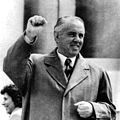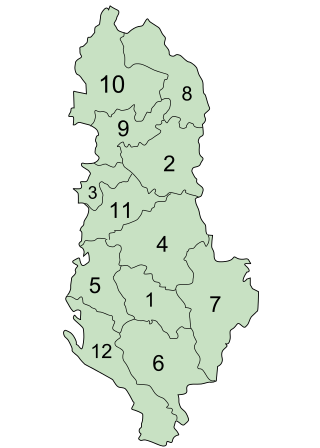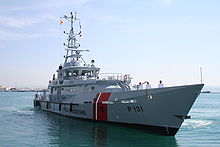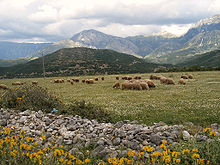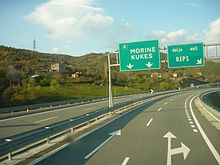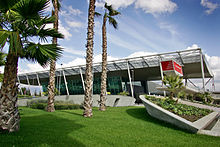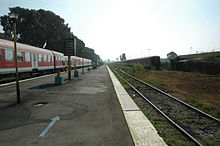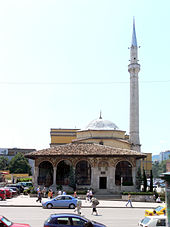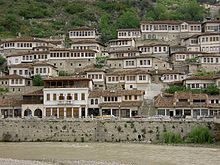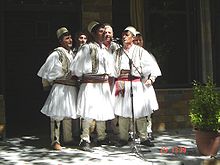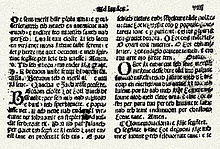
Albania
Background to the schools Wikipedia
SOS Children offer a complete download of this selection for schools for use on schools intranets. Click here to find out about child sponsorship.
| Republic of Albania Republika e Shqipërisë
|
||||||
|---|---|---|---|---|---|---|
|
||||||
Motto: (official)
|
||||||
Anthem:
|
||||||
|
Location of Albania (green)
in Europe (dark grey) — [ Legend] |
||||||
| Capital and largest city |
Tirana 41°20′N 19°48′E |
|||||
| Official languages | Albaniana | |||||
| Ethnic groups |
|
|||||
| Government | Unitary parliamentary republic | |||||
| - | President | Bujar Nishani | ||||
| - | Prime Minister | Sali Berisha | ||||
| - | Speaker of the Parliament | Jozefina Topalli | ||||
| Legislature | Parliament | |||||
| Formation | ||||||
| - | Principality of Arbër | 1190 | ||||
| - | League of Lezhë | 2 March 1444 | ||||
| - | Independence from the Ottoman Empire |
28 November 1912 | ||||
| - | Recognized by the Great Powers | 29 July 1913 | ||||
| - | Current constitution | 28 November 1998 | ||||
| Area | ||||||
| - | Total | 28,748 km2 ( 143rd) 11,100 sq mi |
||||
| - | Water (%) | 4.7 | ||||
| Population | ||||||
| - | 2011 census | 2,821,977 | ||||
| - | Density | 98.5/km2 ( 63) 251.11/sq mi |
||||
| GDP ( PPP) | 2011 estimate | |||||
| - | Total | $24.910 billion | ||||
| - | Per capita | $8,853 | ||||
| GDP (nominal) | 2011 estimate | |||||
| - | Total | $12.847 billion | ||||
| - | Per capita | $4,536 | ||||
| Gini (2005) | 26.7 low |
|||||
| HDI (2011) | high · 70th |
|||||
| Currency | Lek ( ALL) |
|||||
| Time zone | CET ( UTC+1) | |||||
| - | Summer ( DST) | CEST ( UTC+2) | ||||
| Date format | dd.mm.yyyy | |||||
| Drives on the | right | |||||
| Calling code | 355 | |||||
| ISO 3166 code | AL | |||||
| Internet TLD | .al | |||||
| a. | Greek, Vlach, Macedonian and other regional languages are government-recognized minority languages. | |||||
Albania ( / æ l ˈ b eɪ n i ə / al-BAY-nee-ə, Albanian: Shqipëri/Shqipëria; Gheg Albanian: Shqipni/Shqipnia), officially known as the Republic of Albania ( Albanian: Republika e Shqipërisë pronouncedAlbanian pronunciation: [ɾɛpuˈblika ɛ ʃcipəˈɾiːs]), is a country in Southeastern Europe. It is bordered by Montenegro to the northwest, Kosovo ( Disputed) to the northeast, Macedonia to the east and Greece to the south and southeast. It has a coast on the Adriatic Sea to the west, and on the Ionian Sea to the southwest. It is less than 72 km (45 mi) from Italy, across the Strait of Otranto which links the Adriatic Sea to the Ionian Sea.
Albania is a member of the UN, NATO, the Organization for Security and Co-operation in Europe, Council of Europe, World Trade Organisation, Organisation of Islamic Cooperation and one of the founding members of the Union for the Mediterranean. Albania has been a potential candidate for accession to the European Union since January 2003, and it formally applied for EU membership on 28 April 2009.
The modern-day territory of Albania was at various points in history part of the Roman provinces of Dalmatia (southern Illyricum), Macedonia (particularly Epirus Nova), and Moesia Superior. The modern Republic became independent after the collapse of the Ottoman Empire in Europe following the Balkan Wars. Albanians had for almost five centuries been at the heart of a sprawling empire in which they enjoyed a privileged position as administrators and generals. Albania declared independence in 1912 (to be recognised in 1913), becoming a Principality, Republic, and Kingdom until being invaded by Italy in 1939, which formed Greater Albania, which in turn became a Nazi protectorate in 1943. In 1944, a socialist People's Republic was established under the leadership of Enver Hoxha and the Party of Labour. In 1991, the Socialist republic was dissolved and the Republic of Albania was established.
Albania is a parliamentary democracy with a transition economy. The Albanian capital, Tirana, is home to 421,286 of the country's 2,831,741 people. Free-market reforms have opened the country to foreign investment, especially in the development of energy and transportation infrastructure. Albania was chosen as the No.1 Destination in Lonely Planet's list of ten top countries to visit for 2011.
Etymology and terminology
Albania is the Medieval Latin name of the country which is called Shqipëri by its people. In Medieval Greek, the country's name is Albania besides variants Albanitia, Arbanitia.
The name may be derived from the Illyrian tribe of the Albani recorded by Ptolemy, the geographer and astronomer from Alexandria who drafted a map in 150 AD that shows the city of Albanopolis (located northeast of Durrës).
The name may have a continuation in the name of a medieval settlement called Albanon and Arbanon, although it is not certain this was the same place. In his History written in 1079–1080, Byzantine historian Michael Attaliates was the first to refer to Albanoi as having taken part in a revolt against Constantinople in 1043 and to the Arbanitai as subjects of the Duke of Dyrrachium. During the Middle Ages, the Albanians called their country Arbër or Arbën and referred to themselves as Arbëresh or Arbnesh.
As early as the 16th century the placename Shqipëria and the ethnic demonym Shqiptarë gradually replaced Arbëria and Arbëresh. While the two terms are popularly interpreted as "Land of the Eagles" and "Children of the Eagles", they derive from the adverb shqip, which means "understanding each other". Under the Ottoman Empire Albania was referred to officially as Arnavutluk and its inhabitants as Arnauts (officially Arnavutlar). These terms remain the same officially and in common usage in the current Republic of Turkey. The word is considered to be a metathesis from the word Arvanite, which was the Medieval Greek name for the Albanians.
History
The history of Albania emerged from the prehistoric stage from the 4th century BC, with early records of Illyria in Greco-Roman historiography. The modern territory of Albania has no counterpart in antiquity, comprising parts of the Roman provinces of Dalmatia (southern Illyricum) and Macedonia(particularly Epirus Nova). The territory remained under Roman ( Byzantine) control until the Slavic migrations of the 7th century, and was integrated into the Bulgarian Empire in the 9th century. The territorial nucleus of the Albanian state formed in the Middle Ages, as the Principality of Arbër and the Kingdom of Albania. The first records of the Albanian people as a distinct ethnicity also date to this period.
Ottoman Period
At the dawn of the establishment of the Ottoman Empire in Southeast Europe, the geopolitical landscape was marked by scattered kingdoms of small principalities. The Ottomans erected their garrisons throughout southern Albania by 1415 and established formal jurisdiction over most of Albania by 1431. Along with the Bosniaks, Muslim Albanians occupied an outstanding position in the empire, and were the main pillars of Ottoman policy in the Balkans.
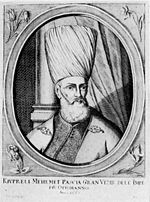
Enjoying this privileged position in the empire, Muslim Albanians held various administrative positions, with over two dozen Grand Viziers of Albanian origin, such as Gen. Köprülü Mehmed Pasha, who commanded the Ottoman forces during the Ottoman-Persian Wars; Gen. Köprülü Fazıl Ahmed, who led the Ottoman army during the Austro-Turkish War (1663–1664); and, later, Muhammad Ali Pasha of Egypt. In the 15th century, when the Ottomans were gaining a firm foothold in the region, Albanian towns were organised into four principal sanjaks. The government fostered trade by settling a sizeable Jewish colony of refugees fleeing persecution in Spain (at end of the 15th century). Vlorë saw passing through its ports imported merchandise from Europe such as velvets, cotton goods, mohairs, carpets, spices and leather from Bursa and Istanbul. Some citizens of Vlorë even had business associates in Europe.
Albanians could also be found throughout the empire, in Iraq, Egypt, Algeria and across the Maghreb as vital military and administrative retainers. This owed largely to their early use as part of the Devşirme system. The process of Islamization was an incremental one, commencing from the arrival of the Ottomans in the 14th century (to this day, a minority of Albanians are Catholic or Orthodox Christians, though the vast majority became Muslim). Timar holders, the bedrock of early Ottoman control in Southeast Europe, were not necessarily converts to Islam, and occasionally rebelled; the most famous of these rebels is Skanderbeg (his figure would be used later in the 19th century as a central component of Albanian national identity). The most significant impact on the Albanians was the gradual Islamisation process of a large majority of the population, although such a process only became widespread in the 17th century. Mainly Catholics converted in the 17th century, while the Orthodox Albanians followed suit mainly in the following century. Initially confined to the main city centres of Elbasan and Shkoder, by this period the countryside was also embracing the new religion. The motives for conversion according to scholars were diverse, depending on the context. The lack of source material does not help when investigating such issues.
Albania remained under Ottoman control as part of the Rumelia province until 1912, when the first independent Albanian state was declared. The formation of an Albanian national consciousness dates to the latter 19th century and is part of the larger phenomenon of the rise of nationalism under the Ottoman Empire.
Era of Nationalism
The first organization that opposed the partition of Albania and pushed for greater autonomy was the League of Prizren, formed on 1 June 1878, in Prizren, Kosovo. The League used military force to prevent the annexing of northern Albanian areas assigned to Montenegro and Serbia, and southern Albanian areas assigned to Greece by the Congress of Berlin. After several battles with Montenegrin troops, the league was forced to give up Ulcinj to Montenegro and then was defeated by the Ottoman army sent by the Sultan in order to prevent the league from achieving autonomy for Albania. The uprisings of 1910–1912, the Ottoman defeat in the Balkan Wars and the advancing Montenegrin, Serbian and Greek armies into the territories where Albanians were majority, led to the proclamation of independence by Ismail Qemali in Vlora, on 28 November 1912.
Independence
Albania's independence was recognized by the Conference of London on 29 July 1913, but the drawing of the borders of Albania ignored the demographic realities of the time. The short-lived monarchy (1914–1925) was succeeded by an even shorter-lived first Albanian Republic (1925–1928), to be replaced by another monarchy (1928–1939), which was annexed by Fascist Italy and then by Nazi Germany during World War II.
Socialist Albania
After the liberation of Albania from Nazi occupation, the country became a socialist republic, the People's Republic of Albania (renamed "the People's Socialist Republic of Albania" in 1976), which was led by Enver Hoxha and the Party of Labour of Albania.
The socialist reconstruction of Albania after WWII and the national liberation was launched immediately after the annulling of the monarchy and the establishment of a " People's Republic". In 1947, Albania's first railway line was completed, with the second completed within eight months after. After new laws of land reform, land was granted to workers and peasants who tilled it. Agriculture began to become cooperative labour and production increased significantly, leading to Albania becoming agriculturally self-sufficient. By 1955, illiteracy was eliminated among Albania's adult population.
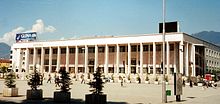
During this period Albania became industrialised and saw rapid economic growth, as well as unprecedented progress in the areas of education and health. The average annual rate of increase of Albania's national income was 29% higher than the world average and 56% higher than the European average. Also during this period, because of the monopolised socialist economy, Albania was the only country in the world that imposed no imposts or taxes on its people. Hoxha's political successor Ramiz Alia oversaw the disintegration of the " Hoxhaist" state during the wider collapse of the Eastern Bloc in the later 1980s.
Religious freedoms were severely curtailed during this period, with many forms of worship being outlawed. In August 1945, the Agrarian Reform Law meant that large swaths of property owned by religious groups (mostly Islamic waqfs) were nationalized, along with the estates of monasteries and dioceses. Many believers, with the ulema, and many priests were arrested, tortured and executed. In 1949, a new Decree on Religious Communities required that they and all their activities be sanctioned by the state alone. In 1967 Hoxha proclaimed Albania the world's first ' atheist state'. Hundreds of mosques and dozens of Islamic libraries — containing priceless manuscripts — were destroyed. Churches were not spared either, and many were converted into cultural centers for young people. The new law banned all "fascist, religious, warmongerish, antisocialist activity and propaganda"; preaching religion carried a three- to ten-year prison sentence. Nonetheless, many Albanians continued to practice in secret.
Contemporary Albania
The People's Republic was dissolved in 1990, and the Republic of Albania was founded in 1991. The Communists retained a stronghold in parliament after popular support in the elections of 1991. However, in March 1992, amid liberalisation policies resulting in economic collapse and social unrest, a new front led by the new Democratic Party took power. The economic crisis spread in late 1996 following the failure of some Ponzi schemes operating in the country, peaking in 1997 in an armed rebellion that led to another mass emigration of Albanians, mostly to Italy, Greece, Switzerland, Germany and North America.
In 1999, the country was affected by the Kosovo War, when a great number of Albanians from Kosovo found refuge in Albania.
Albania became a full member of NATO in 2009. The country is applying to join the European Union.
Albanian state flag
| 1912 |  |
Albanian Declaration of Independence | Declaration of independence of the Albanian Vilayet from the Ottoman Empire. Proclaimed in Vlorë on 28 November 1912. |
| 1912-1914 |  |
Independent Albania | Parliamentary state and assembly established in Vlorë on 28 November 1912. The senate were established on 4 December 1912. Leader Ismail Qemali |
| 1914–1925 |  |
Principality of Albania | Short-lived monarchy headed by William, Prince of Albania until the abolition of the monarchy in 1925, |
| 1925–1928 |  |
Albanian Republic | Official name as enshrined in the Constitution of 1925. A protectorate of the Kingdom of Italy after the Treaties of Tirana of 1926 and 1927 |
| 1928–1939 |  |
Albanian Kingdom | Constitutional monarchal rule between 1928 and 1939. A de facto protectorate of the Kingdom of Italy |
| 1939–1943 |  |
Albanian Kingdom under Italy | A protectorate of the Kingdom of Italy. Led by Italy's King Victor Emmanuel III Ruled by Italian governors after military occupation by Italy from 1939-1943. Ceased to exist as an independent country. Part of the Italian Empire |
| 1943–1944 | Albanian Kingdom under Germany | A de jure independent country, between 1943 and 1944. Germans took control after the Armistice with Italy on 8 September 1943. |
|
| 1944–1992 |  |
People's Socialist Republic of Albania | From 1944 to 1946 it was known as the Democratic Government of Albania. From 1946-1976 it was known as the People's Republic of Albania. |
| since 1992 |  |
Republic of Albania | In 1991 the Socialist Party of Albania took control through democratic elections. In 1992 the Democratic Party of Albania won the new elections. |
Administrative divisions
Albania is divided into 12 administrative counties ( Albanian: qark or prefekturë). These counties include 36 districts ( Albanian: rreth) and 373 municipalities ( Albanian: bashki or komunë). 72 municipalities have city status ( Albanian: qytet). There are overall 2980 villages/communities ( Albanian: fshat) in all Albania. Each district has its council which is composed of a number of municipalities. The municipalities are the first level of local governance, responsible for local needs and law enforcement.
| County | Capital | Districts | Municipalities | Cities | Villages | |
|---|---|---|---|---|---|---|
| 1 | Berat | Berat | Berat Kuçovë Skrapar |
10 2 8 |
2 1 2 |
122 18 105 |
| 2 | Dibër | Peshkopi | Bulqizë Dibër Mat |
7 14 10 |
1 1 2 |
63 141 76 |
| 3 | Durrës | Durrës | Durrës Krujë |
6 4 |
4 2 |
62 44 |
| 4 | Elbasan | Elbasan | Elbasan Gramsh Librazhd Peqin |
20 9 9 5 |
3 1 2 1 |
177 95 75 49 |
| 5 | Fier | Fier | Fier Lushnjë Mallakastër |
14 14 8 |
3 2 1 |
117 121 40 |
| 6 | Gjirokastër | Gjirokastër | Gjirokastër Përmet Tepelenë |
11 7 8 |
2 2 2 |
96 98 77 |
| 7 | Korçë | Korçë | Devoll Kolonjë Korçë Pogradec |
4 6 14 7 |
1 2 2 1 |
44 76 153 72 |
| 8 | Kukës | Kukës | Has Kukës Tropojë |
3 14 7 |
1 1 1 |
30 89 68 |
| 9 | Lezhë | Lezhë | Kurbin Lezhë Mirditë |
4 9 5 |
3 1 2 |
26 62 80 |
| 10 | Shkodër | Shkodër | Malësi e Madhe Pukë Shkodër |
5 8 15 |
1 2 2 |
56 75 141 |
| 11 | Tirana | Tirana | Kavajë Tirana |
8 16 |
2 3 |
66 167 |
| 12 | Vlorë | Vlorë | Delvinë Sarandë Vlorë |
3 7 9 |
1 2 4 |
38 62 99 |
Government, politics and armed forces
The Albanian republic is a parliamentary democracy established under a constitution renewed in 1998. Elections are held every four years to a unicameral 140-seat chamber, the People's Assembly. In June 2002, a compromise candidate, Alfred Moisiu, former Army General, was elected to succeed President Rexhep Meidani. Parliamentary elections in July 2005 brought Sali Berisha, the leader of the Democratic Party, while on 20 July 2007 Bamir Topi became president. The current Albanian president Bujar Nishani was elected by Parliament in July 2012.
The Euro-Atlantic integration of Albania has been the ultimate goal of the post-communist governments. Albania's EU membership bid has been set as a priority by the European Commission.
Albania, along with Croatia, joined NATO on 1 April 2009, becoming the 27th and 28th members of the alliance.
Executive branch
The head of state in Albania is the President of the Republic. The President is elected to a 5-year term by the Assembly of the Republic of Albania by secret ballot, requiring a 50%+1 majority of the votes of all deputies. The current President of the Republic is Bujar Nishani elected on July 2012.
The President has the power to guarantee observation of the constitution and all laws, act as commander in chief of the armed forces, exercise the duties of the Assembly of the Republic of Albania when the Assembly is not in session, and appoint the Chairman of the Council of Ministers (prime minister).
Executive power rests with the Council of Ministers (cabinet). The Chairman of the Council (prime minister) is appointed by the president; ministers are nominated by the president on the basis of the prime minister's recommendation. The People's Assembly must give final approval of the composition of the Council. The Council is responsible for carrying out both foreign and domestic policies. It directs and controls the activities of the ministries and other state organs.
| President | Bujar Nishani | PD | 24 July 2012 |
|---|---|---|---|
| Prime Minister | Sali Berisha | PD | 9 September 2009 |
Legislative branch
The Assembly of the Republic of Albania (Kuvendi i Republikës së Shqipërisë) is the lawmaking body in Albania. There are 140 deputies in the Assembly, which are elected through a party-list proportional representation system. The President of the Assembly (or Speaker), who has two deputies, chairs the Assembly. There are 15 permanent commissions, or committees. Parliamentary elections are held at least every four years.
The Assembly has the power to decide the direction of domestic and foreign policy; approve or amend the constitution; declare war on another state; ratify or annul international treaties; elect the President of the Republic, the Supreme Court, and the Attorney General and his or her deputies; and control the activity of state radio and television, state news agency and other official information media.
Armed forces
The Albanian Armed Forces (Forcat e Armatosura të Shqipërisë) were first formed after independence in 1912. Albania reduced the number of active troops from 65,000 in 1988 to 14,500 in 2009 and the military now consists mainly of a small fleet of aircraft and sea vessels. In the 1990s, the country scrapped enormous amounts of obsolete hardware, such as tanks and SAM systems from China.
Today, it consists of the General Staff Headquarters, the Albanian Land Forces, Albanian Air Force, Albanian Naval Defense Forces, the Albanian Logistic Brigade and the Albanian Training and Doctrine Command. Increasing the military budget was one of the most important conditions for NATO integration. Military spending has generally been lower than 1.5% since 1996 only to peak in 2009 at 2% and fall again to 1.5%. Since February 2008, Albania participates officially in NATO's Operation Active Endeavor in the Mediterranean Sea. It received a NATO membership invitation on 3 April 2008. Albania became a full member of NATO on 1 April 2009.
Geography
Albania has a total area of 28,748 square kilometers. It lies between latitudes 39° and 43° N, and mostly between longitudes 19° and 21° E (a small area lies east of 21°). Albania's coastline length is 611 km (380 mi) and extends along the Adriatic and Ionian Seas. The lowlands of the west face the Adriatic Sea. The 70% of the country that is mountainous is rugged and often inaccessible from the outside. The highest mountain is Korab situated in the district of Dibër, reaching up to 2,753 metres (9,032 ft). The climate on the coast is typically Mediterranean with mild, wet winters and warm, sunny, and rather dry summers.
Inland conditions vary depending on altitude, but the higher areas above 1,500 m/5,000 ft are rather cold and frequently snowy in winter; here cold conditions with snow may linger into spring. Besides the capital city of Tirana, which has 800,000 inhabitants, the principal cities are Durrës, Korçë, Elbasan, Shkodër, Gjirokastër, Vlorë and Kukës. In Albanian grammar, a word can have indefinite and definite forms, and this also applies to city names: both Tiranë and Tirana, Shkodër and Shkodra are used.
The three largest and deepest tectonic lakes of the Balkan Peninsula are partly located in Albania. Lake Shkodër in the country's northwest has a surface which can vary between 370 km2 (140 sq mi) and 530 km2, out of which one third belongs to Albania and rest to Montenegro. The Albanian shoreline of the lake is 57 km (35 mi). Ohrid Lake is situated in the country's southeast and is shared between Albania and Republic of Macedonia. It has a maximal depth of 289 meters and a variety of unique flora and fauna can be found there, including "living fossils" and many endemic species. Because of its natural and historical value, Ohrid Lake is under the protection of UNESCO. There is also Butrinti Lake which is a small tectonic lake. It is located in the national park of Butrint.
Climate
With its coastline facing the Adriatic and Ionian seas, its highlands backed upon the elevated Balkan landmass, and the entire country lying at a latitude subject to a variety of weather patterns during the winter and summer seasons, Albania has a high number of climatic regions relative to its landmass. The coastal lowlands have typically Mediterranean weather; the highlands have a Mediterranean continental climate. In both the lowlands and the interior, the weather varies markedly from north to south.
The lowlands have mild winters, averaging about 7 °C (45 °F). Summer temperatures average 24 °C (75 °F). In the southern lowlands, temperatures average about 5 °C (9 °F) higher throughout the year. The difference is greater than5 °C (9 °F) during the summer and somewhat less during the winter.
Inland temperatures are affected more by differences in elevation than by latitude or any other factor. Low winter temperatures in the mountains are caused by the continental air mass that dominates the weather in Eastern Europe and the Balkans. Northerly and northeasterly winds blow much of the time. Average summer temperatures are lower than in the coastal areas and much lower at higher elevations, but daily fluctuations are greater. Daytime maximum temperatures in the interior basins and river valleys are very high, but the nights are almost always cool.
Average precipitation is heavy, a result of the convergence of the prevailing airflow from the Mediterranean Sea and the continental air mass. Because they usually meet at the point where the terrain rises, the heaviest rain falls in the central uplands. Vertical currents initiated when the Mediterranean air is uplifted also cause frequent thunderstorms. Many of these storms are accompanied by high local winds and torrential downpours.
When the continental air mass is weak, Mediterranean winds drop their moisture farther inland. When there is a dominant continental air mass, cold air spills onto the lowland areas, which occurs most frequently in the winter. Because the season's lower temperatures damage olive trees and citrus fruits, groves and orchards are restricted to sheltered places with southern and western exposures, even in areas with high average winter temperatures.
Lowland rainfall averages from 1,000 millimeters (39.4 in) to more than 1,500 millimeters (59.1 in) annually, with the higher levels in the north. Nearly 95% of the rain falls in the winter.
Rainfall in the upland mountain ranges is heavier. Adequate records are not available, and estimates vary widely, but annual averages are probably about 1,800 millimeters (70.9 in) and are as high as 2,550 millimeters (100.4 in) in some northern areas. The western Albanian Alps (valley of Boga) are among the wettest areas in Europe, receiving some 3,100 mm (122.0 in) of rain annually. The seasonal variation is not quite as great in the coastal area.
The higher inland mountains receive less precipitation than the intermediate uplands. Terrain differences cause wide local variations, but the seasonal distribution is the most consistent of any area.
In 2009 an expedition from University of Colorado discovered four small glaciers in the 'Cursed' mountains in North Albania. The glaciers are at the relatively low level of 2,000 meters – almost unique for such a southerly latitude.
Flora and fauna
Although a small country, Albania is distinguished for its rich biological diversity. The variation of geomorphology, climate and terrain create favorable conditions for a number of endemic and sub-endemic species with 27 endemic and 160 subendemic vascular plants present in the country. The total number of plants is over 3250 species, approximately 30% of the entire flora species found in Europe.
Over a third of the territory of Albania – about 10,000 square kilometers (2.5 million acres) – is forested and the country is very rich in flora. About 3,000 different species of plants grow in Albania, many of which are used for medicinal purposes. Phytogeographically, Albania belongs to the Boreal Kingdom and is shared between the Adriatic and East Mediterraneanprovinces of the Mediterranean Region and the Illyrian province of the Circumboreal Region. Coastal regions and lowlands have typical Mediterranean macchia vegetation, whereas oak forests and vegetation are found on higher altitudes. Vast forests of black pine, beech and fir are found on higher mountains and alpine grasslands grow at altitudes above 1800 meters.
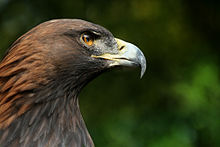
According to the World Wide Fund for Nature and Digital Map of European Ecological Regions by the European Environment Agency, the territory of Albania can be subdivided into three ecoregions: the Illyrian deciduous forests, Pindus Mountains mixed forests and Dinaric Alpine mixed forests. The forests are home to a wide range of mammals, including wolves, bears, wild boars and chamois. Lynx, wildcats, pine martens and polecats are rare, but survive in some parts of the country.
There are around 760 vertebrate species found so far in Albania. Among these there are over 350 bird species, 330 freshwater and marine fish and 80 mammal species. There are some 91 globally threatened species found within the country, among which the Dalmatian pelican, Pygmy cormorant, and the European sea sturgeon. Rocky coastal regions in the south provide good habitats for the endangered Mediterranean monk seal.
Some of the most significant bird species found in the country include the golden eagle – known as the national symbol of Albania – vulture species, capercaillie and numerous waterfowl. The Albanian forests still maintain significant communities of large mammals such as the brown bear, gray wolf, chamois and wild boar. The north and eastern mountains of the country are home to the last remaining Balkan Lynx – a critically endangered population of the Eurasian lynx.
Economy
Albania's troubled transition from communist to free-market capitalism has been largely successful. There are signs of increasing investments, and power cuts are reduced to the extent that Albania is now exporting energy. Its GDP per capita (expressed in PPS— Purchasing Power Standards) stood at 28 percent of the EU average in 2010. Still, Albania has shown potential for economic growth, as more and more businesses relocate there and consumer goods are becoming available from emerging market traders as part of the current massive global cost-cutting exercise. Albania, Cyprus, and Poland are the only countries in Europe that recorded economic growth in the first quarter of 2010. International Monetary Fund (IMF) predicted 2.6% growth for Albania in 2010 and 3.2% in 2011.
Albania and Croatia have discussed the possibility of jointly building a nuclear power plant at Lake Shkoder, close to the border with Montenegro, a plan that has gathered criticism from Montenegro due to seismicity in the area. In addition, there is some doubt whether Albania would be able to finance a project of such a scale with a total national budget of less than $5 billion. However, in February 2009 Italian company Enel announced plans to build an 800 MW coal-fired power plant in Albania, to diversify electricity sources. Nearly 100% of the electricity is generated by ageing hydroelectric power plants, which are becoming more ineffective due to increasing droughts.
The country has some deposits of petroleum and natural gas, but produced only 5,400 barrels of oil per day as of 2009. Natural gas production, estimated at about 30 million cubic meters, is sufficient to meet consumer demands. Other natural resources include coal, bauxite, copper and iron ore.
Agriculture is the most significant sector, employing some 58% of the labor force and generating about 21% of GDP. Albania produces significant amounts of wheat, corn, tobacco, figs (13th largest producer in the world) and olives.
Tourism is gaining a fair share of Albania's GDP with visitors growing every year.
The workforce of Albania has continued to migrate to Greece, Italy, Germany, other parts of Europe, and North America. However, the migration flux is slowly decreasing, as more and more opportunities are emerging in Albania itself as its economy steadily develops.
Crime and Law Enforcement
Law Enforcement in Albania is primarily the responsibility of the Albanian Police. Albania also has a counter-terrorism unit called RENEA. On a list of 75 countries, Albania listed at 17th lowest crime rate ahead of many western nations such as Denmark, the United Kingdom, Sweden and France. However, homicide is still a problem in the country, especially blood feuds in rural areas of the north, though most of these crimes are targeted at specific people and not random by passers.
Science and technology
From 1993 human resources in sciences and technology have drastically decreased. Various surveys show that during 1991–2005, approximately 50% of the professors and research scientists of the universities and science institutions in the country have emigrated.
However in 2009 the government approved the "National Strategy for Science, Technology and Innovation in Albania" covering the period 2009–2015. It aims to triple public spending on research and development (R&D) to 0.6% of GDP and augment the share of gross domestic expenditure on R&D from foreign sources, including via the European Union's Framework Programmes for Research, to the point where it covers 40% of research spending, among others.
Transport
Highways
Currently there are two main motorways in Albania: the dual carriageway connecting Durrës with Vlore and the Albania-Kosovo Highway.
The Albania-Kosovo Highway links Kosovo to Albania's Adriatic coast: the Albanian side was completed in June 2009, and now it takes only two hours and a half to go from the Kosovo border to Durrës. Overall the highway will be around 250 km (155 mi) when it reaches Pristina. The project was the biggest and most expensive infrastructure project ever undertaken in Albania. The cost of the highway appears to have breached €800 million, although the exact cost for the total highway has yet to be confirmed by the government.
Two additional highways will be built in Albania in the near future: Corridor VIII, which will link Albania with the Republic of Macedonia and Bulgaria, and the north-south highway, which corresponds to the Albanian side of the Adriatic–Ionian motorway, a larger regional highway connecting Croatia with Greece along the Adriatic and Ionian coasts. When all three corridors are completed Albania will have an estimated 759 kilometers of highway linking it with all its neighboring countries: Kosovo, the Republic of Macedonia, Montenegro, and Greece.
Aviation
The civil air transport in Albania marked its beginnings in November 1924, when the Republic of Albania signed a governmental agreement with German Air Company Deutsche Luft Hansa. On the basis of a ten-year concession agreement, the Albanian Airlines Company Adria Aero Lloyd was established. In the spring of 1925, the first domestic flights from Tirana to Shkoder and Vlora began.
In August 1927, the office of Civil Aviation of Air Traffic Ministry of Italy purchased Adria Aero Lloyd. The company, now in Italian hands, expanded its flights to other cities, such as Elbasan, Korça, Kukësi, Peshkopia and Gjirokastra, and opened up international lines to Rome, Milan, Thessaloniki, Sofia, Belgrade, and Podgorica.
The construction of a more modern airport in Lapraka started in 1934 and was completed by the end of 1935. This new airport, which was later officially named "Airport of Tirana", was constructed in conformity with optimal technological parameters of that time, with a reinforced concrete runway of 2,700 m (8,858 ft), and complemented with technical equipment and appropriate buildings.
During 1955–1957, the Rinasi Airport was constructed for military purposes. Later, its administration was shifted to the Ministry of Transport. On 25 January 1957 the State-owned Enterprise of International Air Transport ( Albtransport) established its headquarters in Tirana. Aeroflot, Jat Airways, Malev, Tarom and Interflug were the air companies that started to have flights with Albania until 1960.
During 1960–1978, several airlines ceased to operate in Albania due to the impact of the politics, resulting in a decrease of influx of flights and passengers. In 1977 Albania's government signed an agreement with Greece to open the country's first air links with non-communist Europe. As a result, Olympic Airways was the first non-communist airline to commercially fly into Albania after World War II. By 1991 Albania had air links with many major European cities, including Paris, Rome, Zurich, Vienna and Budapest, but no regular domestic air service.
A French-Albanian joint venture Ada Air, was launched in Albania as the first private airline, in 1991. The company offered flights in a thirty-six-passenger airplane four days a week between Tirana and Bari, Italy and a charter service for domestic and international destinations.
From 1989 to 1991, because of political changes in the Eastern European countries, Albania adhered to the International Civil Aviation Organization ( ICAO), opened its air space to international flights, and had its duties of Air Traffic Control defined. As a result of these developments, conditions were created to separate the activities of air traffic control from Albtransport. Instead, the National Agency of Air Traffic (NATA) was established as an independent enterprise. In addition, during these years, governmental agreements of civil air transport were established with countries such as Bulgaria, Germany, Slovenia, Italy, Russia, Austria, the UK and Macedonia. The Directory General of Civil Aviation (DGCA) was established on 3 February 1991, to cope with the development required by the time. As of 2007 Albania has one international airport: Tirana International Airport Nënë Tereza. The airport is linked to 29 destinations by 14 airlines. It has seen a dramatic rise in passenger numbers and aircraft movements since the early 1990s. The data for 2009 is 1.3 million passengers served and an average of 44 landings and takeoffs per day.
Railways
The railways in Albania are administered by the national railway company Hekurudha Shqiptare (HSH) (which means Albanian Railways). It operates a 1,435 mm (4 ft 8 1⁄2 in) gauge (standard gauge) rail system in Albania. All trains are hauled by Czech-built ČKD diesel-electric locomotives.
The railway system was extensively promoted by the totalitarian regime of Enver Hoxha, during which time the use of private transport was effectively prohibited. Since the collapse of the former regime, there has been a considerable increase in car ownership and bus usage. Whilst some of the country's roads are still in very poor condition, there have been other developments (such as the construction of a motorway between Tirana and Durrës) which have taken much traffic away from the railways.
Demographics
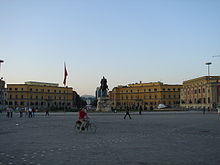
| Population in Albania | |||
|---|---|---|---|
| Year | Million | ||
| 1971 | 2.2 | ||
| 1990 | 3.3 | ||
| 2008 | 3.1 | ||
| 2011 | 3.2 | ||
| Source: OECD/World Bank | |||
According to the 2011 Census results, the total population of Albania is 2,821,977. Its population is relatively young by European standards, with a median age of 28.9 years. The fall of the Communist regime in 1990 Albania was accompanied with massive migration. External migration was prohibited in Communist Albania while internal one was quite limited, hence this was a new phenomenon. Between 1991 and 2004, roughly 900,000 people have migrated out of Albania, about 600,000 of them settling in Greece. Migration greatly affected Albania's internal population distribution. Population decreased mainly in the North and South of the country while increased in Tirana and Durrës centre districts.
Issues of ethnicity are a delicate topic and subject to debate. "Although official statistics have suggested that Albania is one of the most homogenous countries in the region (with an over 97 per cent Albanian majority) minority groups (such as Greeks, Macedonians, Montenegrins, Roma and Vlachs/Aromanians) have often questioned the official data, claiming a larger share in the country’s population." The last census that contained ethnographic data (before the 2011 one) was conducted in 1989.
According to the 2011 census the population of Albania declared the following ethnic affiliation: Albanians 2,312,356 or 82,58%, Greeks 24,243 or 0,87%, Macedonians 5,512 or 0,20%, Montenegrins 366 or 0,01%, Aromanians 8,266 or 0,30%, Romani 8,301 or 0,30%, Balkan Egyptians 3,368 or 0,12%, Other 2,644 or 009%, Undeclared 390,938 or 13,96%, Not relevant 44,144 or 1,58%. Macedonian and some Greek minority groups have sharply criticized Article 20 of the Census law, according to which a $1,000 fine will be imposed on anyone who will declare an ethnicity other than what is stated on his or her birth certificate. This is claimed to be an attempt to intimidate minorities into declaring Albanian ethnicity, according to them the Albanian government has stated that it will jail anyone who does not participate in the census or refuse to declare his or her ethnicity. Genc Pollo, the minister in charge has declared that: "Albanian citizens will be able to freely express their ethnic and religious affiliation and mother tongue. However, they are not forced to answer these sensitive questions". The amendments criticized do not include jailing or forced declaration of ethnicity or religion, only a fine is envisioned which can be overthrown by court. Greek representatives part of the Albanian parliament and government invited their co-ethnics to register as the only way to improve their status. On the other hand, nationalists,as well as intellectuals, various organizations and, political parties in Albania have expressed their concern that the census might artificially increase the number of Greek minority which might be then exploited by Greece and threaten Albania's territorial integrity. Large parts of Albanians, similarly fear irredentist claims on northern Epirus following Albanians changing their nationality to Greek due to monetary and other benefits.
Albania recognizes three national minorities, Greeks, Macedonians and Montenegrins, and two cultural minorities, Aromanians and Romani people. Other Albanian minorities are Bulgarians, Gorani, Serbs, Balkan Egyptians, Bosniaks and Jews. Regarding the Greeks, "it is difficult to know how many Greeks there are in Albania. The Greek government, it is typically claimed, says that there are around 300,000 ethnic Greeks in Albania, but most western estimates are around 200,000 mark (although EEN puts the number at a probable 100,000). The Albanian government puts the number at only 60,000." The CIA World Factbook estimates the Greek minority at 3% of the total population and the US State Department uses 1.17% for Greeks and 0.23% for other minorities.
Language
Albanian is the official language of Albania. Its standard spoken and written form is revised and merged from the two main dialects, Gheg and Tosk; though, it is notably based more on the Tosk dialect. Shkumbin River is the rough dividing line between the two dialects. Also a dialect of Greek that preserves features now lost in standard modern Greek is spoken in areas inhabited by the Greek minority. Other languages spoken by ethnic minorities in Albania include Vlach, Serbian, Macedonian, Bosnian, Bulgarian, Gorani, and Roma. Macedonian is official in Pustec Municipality in East Albania. According to the 2011 population census, 2,765,610 or 98.767% of the population declared Albanian as their mother tongue ("mother tongue is defined as the first or main language spoken at home during childhood").
Religion
The 2011 Census had declared the following religious affiliations: 56.7% Islam, 10.03% Roman Catholic, 6.75% Albanian Orthodox, 5.49% Unaffiliated, 2.5% Atheist, 2.09% Bektashi, 0.14% Protestant/Evangelical. The CIA World Factbook gives a distribution of 70% Muslims, 20% Eastern Orthodox, and 10% Roman Catholics. A Pew Research Centre demographic study from 2009 put the percentage of Muslims in Albania at 79.9%. In 2009 According to the World Christian Encyclopedia, 38.8% of Albanians are Muslim, 16.1% Orthodox, 16.8% Roman Catholics and Nonreligious 16.6%. According to the US State Department, estimates for active participation in religious services are between 25 and 40%. Gallup Global Reports 2010 shows that religion plays a role to 39% of Albanians, and puts Albania in the list of the 14 least religious countries in the world, with Albania the thirteenth least religious country in the world.
The Albanians first appear in the historical record in Byzantine sources of the late-11th century. At this point, they were already fully Christianised. Christianity was later overtaken by Islam during the centuries of Ottoman rule. After independence (1912) from the Ottoman Empire, the Albanian republican, monarchic and later Communist regimes followed a systematic policy of separating religion from official functions and cultural life. Albania never had an official state religion either as a republic or as a kingdom. In the 20th century, the clergy of all faiths was weakened under the monarchy, and ultimately eradicated during the 1940s and 1950s, under the state policy of obliterating all organized religion from Albanian territories.
The Communist regime that took control of Albania after World War II persecuted and suppressed religious observance and institutions and entirely banned religion to the point where Albania was officially declared to be the world's first atheist state. Religious freedom has returned to Albania since the regime's change in 1992. Albanian Muslim populations (mainly secular and of the Sunni branch) are found throughout the country whereas Orthodox Christians are concentrated in the south and Roman Catholics are found in the north of the country. No reliable data are available on active participation in formal religious services, but estimates range from 25% to 40%.
The first recorded Albanian Protestant was Said Toptani, who traveled around Europe, and in 1853 returned to Tirana and preached Protestantism. He was arrested and imprisoned by the Ottoman authorities in 1864. Mainline evangelical Protestants date back to the work of Congregational and later Methodist missionaries and the work of the British and Foreign Bible Society in the 19th century. The Evangelical Alliance, which is known as VUSh http://www.vush.org/ was founded in 1892. Today VUSh has about 160 member congregations from different Protestant denominations. VUSh organizes marches in Tirana including one against blood feuds in 2010. Bibles are provided by the Interconfessional Bible Society of Albania. The first full Albanian Bible to be printed was the Filipaj translation printed in 1990.
The Seventh-day Adventist Church sent its first missionaries into Albanian territory as early as 1909. Following decades of communist repression, The Albanian Mission of Seventh-day Adventists ( http://adventist.al/) was re-established in Tirana in 1992 and has now over 10 churches and groups throughout the country. Its humanitarian wing, the Adventist Development and Relief Agency (ADRA) is renown for being the first humanitarian organization to enter post-communist Albania.
There are about 4,000 active Jehovah's Witnesses in Albania.
The Church of Jesus Christ of Latter-day Saints (LDS or 'Mormons') involvement in Albania began with humanitarian aid during the 1990s. The first missionaries were sent in 1992 with the Albania Tirana Mission being opened in 1996. As of 2008, there were nearly 2,000 members of the LDS church in Albania, spread throughout ten branches with two purpose-built chapels and one Family History Centre.
Culture
Music and folklore
Albanian folk music falls into three stylistic groups, with other important music areas around Shkodër and Tirana; the major groupings are the Ghegs of the north and southern Labs and Tosks. The northern and southern traditions are contrasted by the "rugged and heroic" tone of the north and the "relaxed" form of the south.
These disparate styles are unified by "the intensity that both performers and listeners give to their music as a medium for patriotic expression and as a vehicle carrying the narrative of oral history", as well as certain characteristics like the use of rhythms such as 3/8, 5/8 and 10/8. The first compilation of Albanian folk music was made by Pjetër Dungu in 1940.
Albanian folk songs can be divided into major groups, the heroic epics of the north, and the sweetly melodic lullabies, love songs, wedding music, work songs and other kinds of song. The music of various festivals and holidays is also an important part of Albanian folk song, especially those that celebrate St. Lazarus Day, which inaugurates the springtime. Lullabies and vajtims are very important kinds of Albanian folk song, and are generally performed by solo women.
Albanian language and literature
Albanian was proven to be an Indo-European language in 1854 by the German philologist Franz Bopp. The Albanian language comprises its own branch of the Indo-European language family.
Some scholars believe that Albanian derives from Illyrian while others claim that it derives from Daco- Thracian. (Illyrian and Daco-Thracian, however, might have been closely related languages; see Thraco-Illyrian.)
Establishing longer relations, Albanian is often compared to Balto-Slavic on the one hand and Germanic on the other, both of which share a number of isoglosses with Albanian. Moreover, Albanian has undergone a vowel shift in which stressed, long o has fallen to a, much like in the former and opposite the latter. Likewise, Albanian has taken the old relative jos and innovatively used it exclusively to qualify adjectives, much in the way Balto-Slavic has used this word to provide the definite ending of adjectives.
The cultural renaissance was first of all expressed through the development of the Albanian language in the area of church texts and publications, mainly of the Catholic region in the North, but also of the Orthodox in the South. The Protestant reforms invigorated hopes for the development of the local language and literary tradition when cleric Gjon Buzuku brought into the Albanian language the Catholic liturgy, trying to do for the Albanian language what Luther did for German.
Meshari (The Missal) by Gjon Buzuku, published in 1555, is considered the first literary work of written Albanian. The refined level of the language and the stabilised orthography must be the result of an earlier tradition of written Albanian, a tradition that is not well understood. However, there is some fragmented evidence, pre-dating Buzuku, which indicates that Albanian was written from at least the 14th century.
The earliest evidence dates from 1332 AD with a Latin report from the French Dominican Guillelmus Adae, Archbishop of Antivari, who wrote that Albanians used Latin letters in their books although their language was quite different from Latin. Other significant examples include: a baptism formula (Unte paghesont premenit Atit et Birit et spertit senit) from 1462, written in Albanian within a Latin text by the Bishop of Durrës, Pal Engjëlli; a glossary of Albanian words of 1497 by Arnold von Harff, a German who had travelled through Albania, and a 15th century fragment of the Bible from the Gospel of Matthew, also in Albanian, but written in Greek letters.
Albanian writings from these centuries must not have been religious texts only, but historical chronicles too. They are mentioned by the humanist Marin Barleti, who, in his book Rrethimi i Shkodrës (The Siege of Shkodër) (1504), confirms that he leafed through such chronicles written in the language of the people (in vernacula lingua).
During the 16th to 17th centuries, the catechism E mbësuame krishterë (Christian Teachings) (1592) by Lekë Matrënga, Doktrina e krishterë (The Christian Doctrine) (1618) and Rituale romanum (1621) by Pjetër Budi, the first writer of original Albanian prose and poetry, an apology for George Castriot (1636) by Frang Bardhi, who also published a dictionary and folklore creations, the theological-philosophical treaty Cuneus Prophetarum (The Band of Prophets) (1685) by Pjetër Bogdani, the most universal personality of Albanian Middle Ages, were published in Albanian. The most famous Albanian writer is probably Ismail Kadare.
Education
Before the establishment of the People's Republic, Albania's illiteracy rate was as high as 85%. Schools were scarce between World War I and World War II. When the People's Republic was established in 1945, the Party gave high priority to wiping out illiteracy. As part of a vast social campaign, anyone between the ages of 12 and 40 who could not read or write was mandated to attend classes to learn. By 1955, illiteracy was virtually eliminated among Albania's adult population. Today the overall literacy rate in Albania is 98.7%; the male literacy rate is 99.2% and female literacy rate is 98.3%. With large population movements in the 1990s to urban areas, the provision of education has undergone transformation as well. The University of Tirana is the oldest university in Albania, founded in October 1957.
Sport
Football is the most popular sport in Albania, both at a participatory and spectator level. The sport is governed by the Football Association of Albania ( Albanian: Federata Shqiptare e Futbollit, F.SH.F.), created in 1930, member of FIFA and a founding member of UEFA. Other sports played include basketball, volleyball, tennis, swimming, rugby union, and gymnastics.
- Albania national football team
- Albania national basketball team
- Albania national futsal team
Entertainment
Radio Televizioni Shqiptar (RTSH) is the public radio and TV broadcaster of Albania, founded in 1938 in Tirana. RTSH runs three television stations named Televizioni Shqiptar (TVSH, TVSH 2, and TVSH Sat), and three radio stations, using the name Radio Tirana in addition to 4 regional radio stations. The international service broadcasts radio programmes in Albanian and seven other languages via medium wave (AM) and short wave (SW). The international service has used the theme from the song "Keputa një gjethe dafine" as its signature tune. The international television service via satellite was launched since 1993 and aims at Albanian communities in Kosovo, Serbia, Macedonia, Montenegro and northern Greece, plus the Albanian diaspora in the rest of Europe. RTSH has a past of being heavily influenced by the ruling party in its reporting, whether that party be left or right wing.
According the National Council of Radio and Television (KKRT), Albania has an estimated 257 media outlets, including 66 radio stations and 67 television stations, with three national, 62 local and more than 50 cable TV stations. Last years Albania has organized several shows as a part of worldwide series like Dancing with the Stars, Big Brother Albania, Albanians Got Talent, The Voice of Albania, and X-Factor Albania.
Health
Health care has been in a steep decline after the collapse of socialism in the country, but a process of modernization has been taking place since 2000. As of the 2000s (decade), there were 51 hospitals in the country, including a military hospital and specialist facilities. Albania has successfully eradicated diseases such as malaria.
Life expectancy is estimated at 77.59 years, ranking 51st worldwide, and outperforming a number of European Union countries, such as Hungary and the Czech Republic. The most common causes of death are circulatory disease followed by cancerous illnesses. Demographic and Health Surveys completed a survey in April 2009, detailing various health statistics in Albania, including male circumcision, abortion and more.
The Faculty of Medicine of the University of Tirana is the main medical school in the country. There are also nursing schools in other cities. Newsweek ranked Albania 57 out of 100 Best Countries in the World in 2010.
The general improvement of health conditions in the country is reflected in the lower mortality rate, down to an estimated 6.49 deaths per 1,000 in 2000, as compared with 17.8 per 1,000 in 1938. In 2000, average life expectancy was estimated at 74 years, compared to 38 years at the end of World War II. Albania's infant mortality rate, estimated at 20 per 1,000 live births in 2000, has also declined over the years since the high rate of 151 per 1,000 live births in 1960. There were 69,802 births in 1999 and the fertility rate in 1999 was 2.5 while the maternal mortality rate was 65 per 100,000 live births in 1993. In addition, in 1997, Albania had high immunization rates for children up to one year old: tuberculosis at 94%; diphtheria, pertussis, and tetanus, 99%; measles, 95%; and polio, 99.5%. In 1996, the incidence of tuberculosis was 23 in 100,000 people. In 1995 there were two reported cases of AIDS and seven cases in 1996. As of 2000 the number of people living with HIV/AIDS was estimated at less than 100. The leading causes of death are cardiovascular disease, trauma, cancer, and respiratory disease.
Cuisine
The cuisine of Albania – as with most Mediterranean and Balkan nations – is strongly influenced by its long history. At different times, the territory which is now Albania has been claimed or occupied by Greece, Serbia, Italy and the Ottoman Turks and each group has left its mark on Albanian cuisine. The main meal of Albanians is the midday meal, which is usually accompanied by a salad of fresh vegetables such as tomatoes, cucumbers, green peppers and olives with olive oil, vinegar and salt. It also includes a main dish of vegetables and meat. Seafood specialties are also common in the coastal cities of Durrës, Sarandë and Vlorë. In high altitude localities, smoked meat and pickled preserves are common.



![Location of Albania (green)in Europe (dark grey) — [Legend]](../../images/1876/187625.png)






